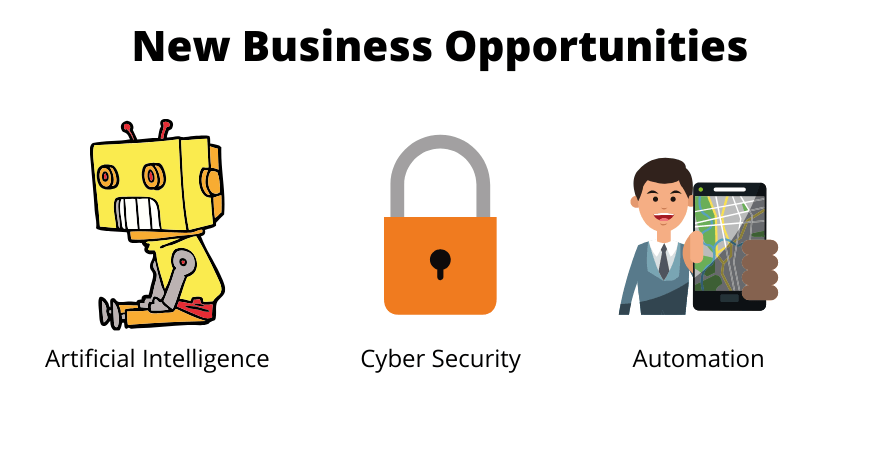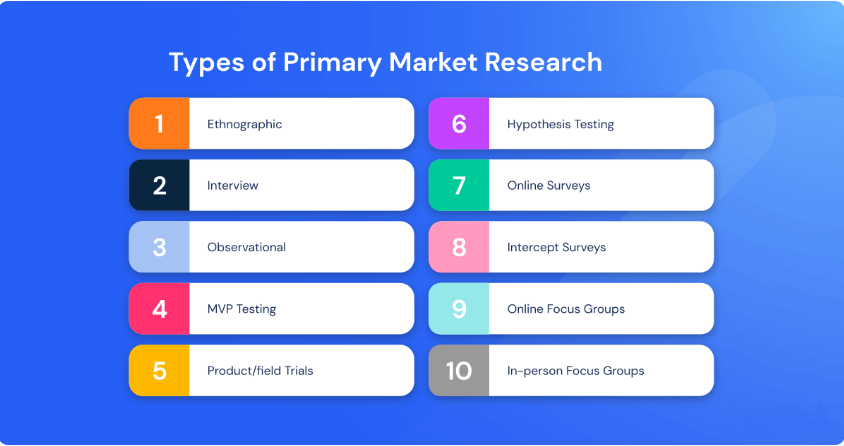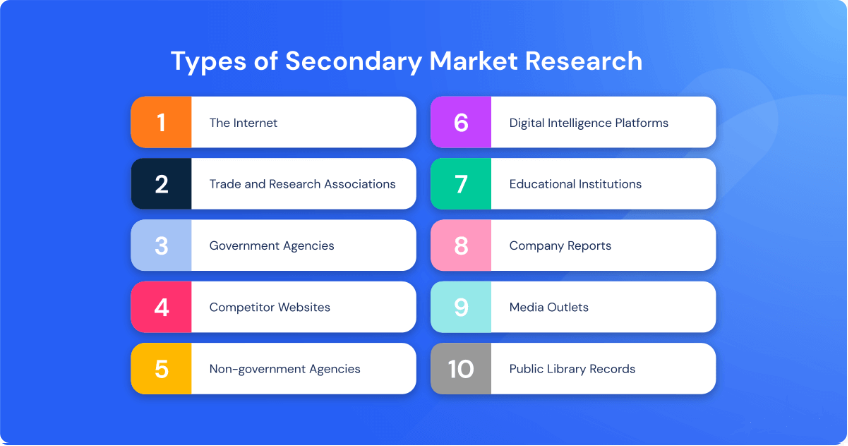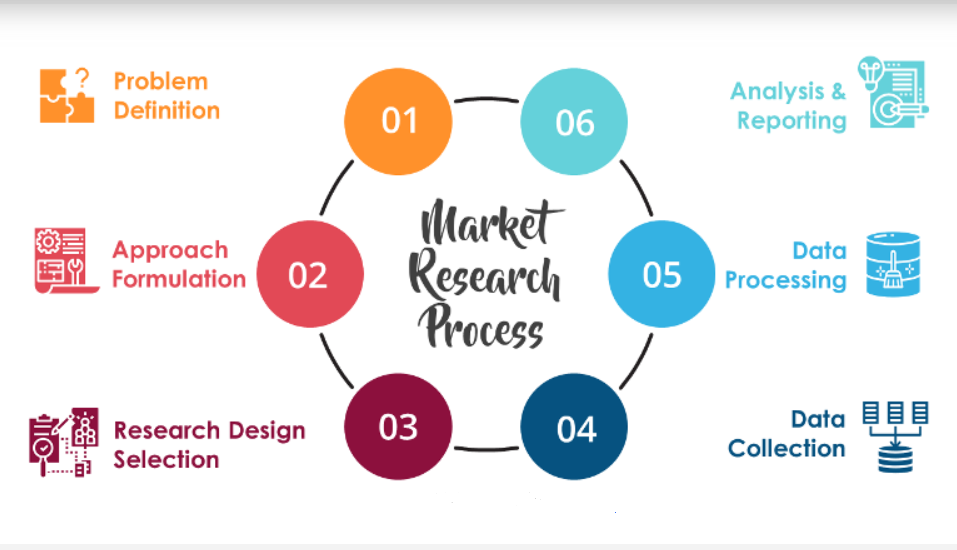If you’re looking to launch a new product or service, the key to success is data-informed decision-making.
As such, businesses need to conduct online market research in order to gain insight into their target audience, competition, and wider industry trends.
While traditional market research methods still have their purposes, conducting online market research provides a wide range of advantages, from enhanced reach to more cost-effective strategies.
That can help any business stand out amongst competitors.
In this blog post, we’ll explain exactly how businesses can harness the power of digital technology through online market research!
What is the Purpose of Online Market Research?
The purpose of online market research is to help businesses gain an understanding of their customer base and better tailor their products and services to meet their needs.
It also helps companies identify new opportunities in the marketplace, such as areas where they can increase sales or new markets to target.
By conducting online market research, businesses can gain valuable insights about their customers, including demographic information, buying behaviour, and preferences for different product types.
This information can be used to develop targeted marketing campaigns that are more likely to reach potential clients.
Online market research has become increasingly popular due to its cost-effective nature and its ability to provide real-time insights into customer behaviour.
Companies no longer need to rely solely on traditional survey methods that take a considerable amount of time and resources to complete.
With online market research tools, such as surveys, focus groups, A/B testing and analytics, companies can quickly gain a comprehensive understanding of their customer base without having to invest in large-scale research projects.
This type of market research also allows companies to track trends over time so they can adjust their strategies accordingly.
For example, if a company notices a decline in sales for one of its products it can use online market research techniques to identify why this may be happening so it can take corrective action if necessary.
Similarly, if a business notices an increase in demand for certain products or services, it can use the same data points to develop campaigns designed specifically for those customers.
In addition to providing useful insights into customers’ buying behaviour, online market research also assists firms with competitive analysis by allowing them to compare their performance against competitors in the industry.
This helps them formulate strategies tailored to achieving competitive advantage within their given sector, which could result in increased profits and customer loyalty over time.
Overall, online market research is an invaluable tool that allows organizations to keep up with changing consumer behaviour trends while gaining valuable insights into how to best serve customers’ needs with greater accuracy.
Its cost-effectiveness makes it attractive for small businesses that may not have the budget for full-scale traditional surveys or focus groups, and its scalability makes it suitable.
For larger corporations looking for detailed data about audiences across multiple markets all over the globe.
1. Getting a Deeper Understanding of Your Target Audience:

A deep understanding of your target audience is essential for successful marketing.
Knowing who you are targeting and their interests, preferences, and needs will enable you to create content that resonates with them.
By understanding your target audience on a deeper level, you can better target them with campaigns and initiatives that will maximize your return on investment (ROI) and ultimately help to grow your business.
First off, it’s important to determine who exactly your target audience is. Do they tend to be younger or older? Are they more likely to be males or females?
How much do they make? What is their education level? These are all key questions that should be answered in order for you to craft messages that appeal to them.
Additionally, gaining knowledge about the language and terms used by this demographic can help you build relationships with them and create trust in the conversation.
It’s also important to gain insight into the channels where your target audience hangs out most often.
After identifying who they are, figure out where they are spending their time online, such as on social media networks like Facebook or Twitter.
What type of content do they engage with most frequently? This could include articles, videos, and podcasts associated with their interests.
Knowing how the intended user group uses each channel will allow you to tailor content specifically and effectively to them.
Another key element of understanding your target audience is being aware of what sparks an emotional reaction in them.
This could include topics related to current events or controversial issues; learning which types of messaging evoke emotion enables you to craft campaigns that leave a lasting impression on potential customers.
Additionally, consider researching their buying habits and find out what items interest them most and why so that when crafting offers or promotions for products or services, those incentives are tailored perfectly for the intended users.
Finally, engaging with this demographic directly can help deepen understanding even further, as it allows for bidirectional communication between you and the customer base.
You can use surveys or focus groups to get direct feedback from these individuals regarding what works best for them in terms of messaging and product features.
This can provide invaluable insights into how best to reach this group effectively while also providing a sense of connection between yourself and potential buyers.
Overall, strengthening your understanding of who makes up your target audience provides many benefits when creating initiatives aimed at increasing conversion rates and ROI by gaining awareness.
Particular demographics allow one to craft content that resonates directly with people within specific user groups, ultimately resulting in better results when attempting to reach desired goals surrounding engagement between customers and businesses alike!
2. Learn Customer Behaviors:

Learning customer behaviours is essential for businesses to remain competitive in the modern market. Understanding your customers’ preferences, motivations, and habits can help businesses create powerful strategies.
That will allow them to offer products and services that truly resonate with their target audience.
In order to better understand customer behaviours, businesses must first establish a baseline understanding of what their customers want and need.
This can be done through surveys, interviews, focus groups and other methods.
Once businesses have a general idea of what their customers are looking for, they can begin to analyse the data they have collected to gain insights into who their customer base is made up of.
Understanding demographic information such as age, gender, location, and income levels can help businesses tailor products and services accordingly.
Businesses must also consider how their customers’ preferences might change over time to stay ahead of the curve.
By monitoring customer trends through regular surveys or interviews and working closely with industry experts, companies can identify emerging trends before they become mainstream.
Anticipating customer needs allows companies to stay one step ahead of competitors by introducing new products or services before anyone else does.
Social media networks now offer an unprecedented opportunity for businesses to learn more about their customers’ behaviours.
Through platforms like Facebook, Twitter, and Instagram, companies have direct access to real-time customer feedback, which they can use to gain insights into what products people are buying, what topics interest them most, etc.
Companies should leverage these platforms not only for marketing purposes but also to gather useful data on customer behaviours, which they can use in product development.
The importance of learning customer behaviour shouldn’t be underestimated when it comes to improving business performance.
A thorough understanding of customer needs leads to more effective marketing campaigns and enables companies to create tailored products and services that meet the exact requirements of potential buyers.
Therefore, businesses must commit resources to understanding customer behaviour if they want to remain competitive in today’s marketplace.
3. Find New Business Opportunities:

Starting a business can be an exciting but daunting challenge. With a global economy and ever-changing markets, there are always opportunities to be found.
However, finding the most profitable and sustainable new business opportunity can be difficult without the right strategies in place.
The key to locating and utilizing new business opportunities is to have a clear understanding of your objectives and goals as well as the target market that you wish to serve.
Researching current trends in both local and international markets will give you a better understanding of what type of products or services are hot right now, allowing you to create something unique that will capture the attention of potential customers.
It is also essential that you gain knowledge about competitors’ strategies and pricing models, which will enable you to devise ways to differentiate yourself from other companies in terms of product quality, customer service, or overall experience.
Another important factor when it comes to discovering new business opportunities is networking.
Assembling a team of professionals who specialize in different areas such as marketing, finance, legal, or HR can help bring various perspectives into one table, which can result in innovative ideas for launching your enterprise.
Additionally, participating in events related to your industry or niche is an excellent way to build relationships with like-minded individuals who may provide valuable advice or even financial support for starting up your venture.
Finally, it’s important not to forget about online resources when searching for new business opportunities.
There are numerous websites offering business advice, including blogs on entrepreneurship and forums dedicated to discussing different aspects of running a company.
Moreover, websites such as Kickstarter allow entrepreneurs to access funding sources and gather feedback from potential customers before introducing their product/service to the market—invaluable information.
Finding the perfect idea for starting a business isn’t easy, especially with so many existing companies competing within the same space.
However, lucrative opportunities that could lead to long-term success can be discovered by researching current market trends and leveraging resources available online (as well as offline)!
2 Types of Market Research:
1. Primary Research

Primary research is a type of scientific inquiry that involves collecting data and information for the purpose of answering specific questions.
Primary research can be conducted in any field or discipline and is often used to help inform decisions about the development of new products, services, and programs.
In essence, primary research is when a researcher collects data and information directly from the source – usually through interviews, focus groups, surveys or experiments.
One of the main advantages of conducting primary research is that it allows you to gain firsthand knowledge about a particular topic or area of interest.
This type of research also helps you accurately capture current attitudes and behaviours that may be changing in real-time due to external factors such as technology, culture, or politics.
Additionally, primary research helps you understand a problem or issue more deeply by examining it from multiple perspectives.
For example, conducting interviews with individuals who have experience with a particular issue can provide valuable insights into how they perceive the problem and how their environment has shaped their experiences.
Another advantage of primary research is that it gives researchers access to unique information that would not be available through secondary sources such as books, journals or websites.
By collecting data directly from individuals involved in an issue, researchers can gather more detailed information than what would otherwise be available through existing literature sources alone.
In addition, this approach allows researchers to ask more open-ended questions so they can obtain additional insight into how people feel about a certain subject matter.
Finally, primary research can provide invaluable insight into how different groups respond to new products or services by allowing researchers to measure variables such as user preferences, customer satisfaction and engagement levels over time.
This allows organizations to make better-informed decisions about product design and customer service strategies based on direct customer feedback rather than relying solely on market trends and assumptions.
In conclusion, primary research offers numerous benefits for businesses seeking to gain deeper knowledge about their customers’ needs and preferences and create better products and services.
It provides an opportunity for researchers to get direct feedback from those most affected by proposed changes or innovations.
This, in turn, allows decision-makers within an organization to make better-informed decisions regarding their desired objectives.
2. Secondary Research

Secondary research involves gathering existing data from sources such as newspapers, books, magazines, websites, and surveys.
It is the most commonly used form of research in fields such as marketing, sociology, economics, education, and public health.
Secondary research can be used to answer questions about a specific product or service, uncover trends in customer behaviour or market conditions, identify competitive advantages or weaknesses, and develop hypotheses for further study.
Secondary research has many advantages over primary research.
First and foremost, it is cost-effective; secondary data is usually available for free or at a lower cost than primary data, which allows researchers to expand their scope without breaking the bank.
Secondarily, it saves time since the researcher does not need to collect the data themselves; they have to search through existing records.
Moreover, since secondary sources often provide a broader scope of information than primary sources, they can be used to compare different products or services across a variety of industries.
The major limitation of secondary research is that the accuracy depends on the quality of the source material being used.
If the source material contains errors or omissions, then these will be reflected in any analysis that relies on them.
Furthermore, what may seem like enough information may not actually be sufficient for making reliable conclusions since secondary resources may not contain all relevant variables or components needed to make a legitimate assessment?
It is important to note that although secondary research can provide valuable insights into customer behaviours or market conditions, it cannot stand alone as evidence in decision-making.
Rather, it should be combined with primary research methods to create an overall picture that is more likely to generate valid conclusions and recommendations.
That said, secondary research still plays an important role in any market analysis as it gives researchers access to a wide range of information at minimal cost and effort.
Quick Links:
- Top Facebook Marketing Companies: Research & Grow Your Business
- How to Market a New Service Effectively?
- How To Build Trust In Relationships With Content Marketing?
- App Marketing Strategies: Choose The Best Strategy
Conclusion: How to Conduct Online Market Research in 2024?
In conclusion, conducting online market research can be extremely beneficial for any brand or business.
Not only does it give you invaluable insights into your target audience’s needs, wants and preferences, but it also tracks the success of your campaigns.
Additionally, by understanding who is engaging with your content, you can continue to make improvements to serve your intended audience better.
With proper planning and execution, businesses can use a range of online tools and platforms to gather valuable data from existing and prospective customers.
There are so many amazing benefits that digital marketing offers to brands today that it’s worth taking advantage of all the available options.
With the right strategies for utilizing each tool and platform, businesses will be able to unlock the full potential of their online market research efforts.

